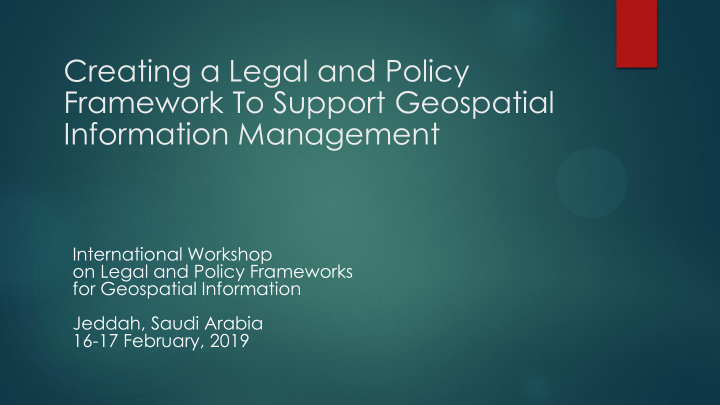



Creating a Legal and Policy Framework To Support Geospatial Information Management International Workshop on Legal and Policy Frameworks for Geospatial Information Jeddah, Saudi Arabia 16-17 February, 2019
Objectives of This Module 2 Identify steps for creating/strengthening a national legal and policy framework that enables geospatial information management.
Enabling Environment Create enabling legislation/policy that supports broad collection/use/distribution of geospatial information: All types of geoinformation Provides for adequate funding levels/support Identifies a lead organization Encourages data access and sharing
Considerations When Developing a Legal and Policy Framework Geospatial community is an ecosystem. A number of different laws and regulations impact geospatial information management. Legal systems vary considerably. There are many different types of geospatial information. Geospatial technology is rapidly changing.
Key Components of a Legal and Policy Framework Binding Elements Legislation and Laws Contracts and Other Agreements Treaties and other international obligations Non-binding Elements Policies Best Practices Standards
Critical Aspects of a Legal and Policy Framework for Geospatial Information Utilization Issues that Impact Governance and Accountability Designation of Lead Organization Data Collection and Governance Sector/Platform Specific Laws
Critical Aspects of a Legal and Policy Framework for Geospatial Information Utilization Issues that Indirectly Impact Geospatial Information Management Intellectual property rights Liability National Security Contract Law Role of Data Sharing Agreements/Data Licenses Open Data
Conduct Gap Analysis Review of existing laws and regulations What laws and regulations are hindering collection/use/sharing of geospatial information? What laws and regulations are needed to facilitate collection/use/sharing of geospatial information? Areas to consider: Intellectual property rights Privacy Liability Sovereign immunity National Security Open Data
Address the Gaps Work with legislators, policymakers, and regulators to address the gaps. At all levels Find examples from other countries (best practices). UN-GGIM website Implementation Guide Tailor to existing legal and policy framework. Work with lawyers, etc.
Make Data Accessible What is government’s plan for making geospatial information accessible? Does it include industry and public? If not, why? Is there a formal policy or legislation or is it informal? How will geospatial community participate in the decision making? Will they have a seat at the table? Are the unique aspects of geospatial information being considered?
Licensing Arrangements Adopt/develop licenses/data sharing agreements for sharing of geospatial information: Resource: Compendium on Licensing of Geospatial Information Understand User base Consult with: Users Lawyers Data providers Industry Government
Future Proof Consider creating Geospatial User Group/Council to consider legal and policy issues associated with future technologies/applications: Drones Autonomous Vehicles Cloud technology Machine learning Internet of Things Augmented Reality/Virtual Reality
Questions Kevin Pomfret kevin@spatiallaw.com +1-804-928-5870 @kpomfret
Recommend
More recommend